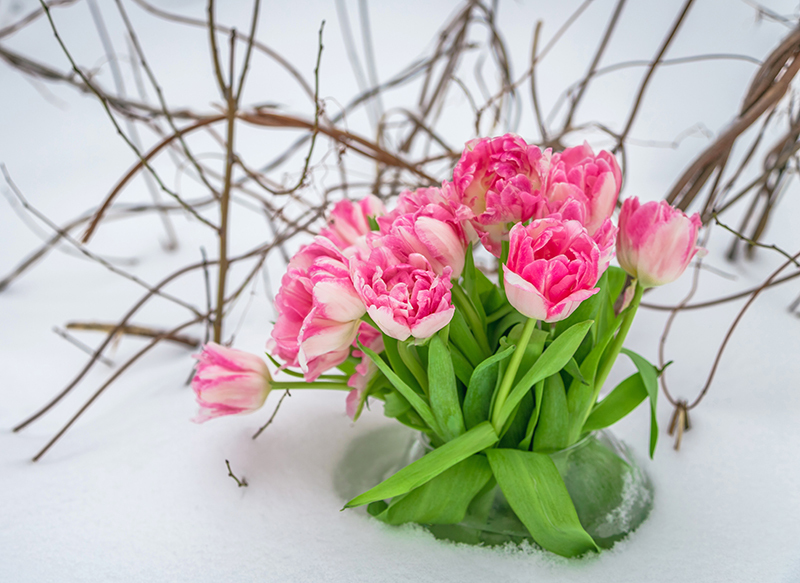The Fascinating Link Between Your Birth Flower and Your Identity
Posted on 21/08/2025
The Fascinating Link Between Your Birth Flower and Your Identity
Have you ever wondered how your birth flower might influence your personality, traits, and identity? Just like birthstones and zodiac signs, birth flowers are said to carry symbolic meanings and characteristics that echo the individuals born in their corresponding months. In this comprehensive guide, we will dive deep into the intriguing connection between birth flowers and personal identity, how you can discover your own birth bloom, and the fascinating stories behind each floral symbol.

Understanding Birth Flowers: More Than Just a Pretty Bloom
From ancient times, humans have associated specific flowers with months, rituals, and even personal qualities. The birth flower tradition is no different. Each month is assigned one or more flowers, each with its own unique symbolism, lore, and meaning. These flowers are believed to reflect the characteristics, emotional patterns, and even destiny of those born beneath their petals.
- Historical roots: The concept of the "birth flower" can be traced back centuries, often linked to floral symbolism in mythology and folklore.
- Cultural significance: Many cultures use flowers in naming, ceremonies, and rites of passage, further strengthening the role of flowers in shaping identity.
- Personal symbolism: Birth flowers are often included in birthday bouquets, gifts, and even tattoos--personal talismans imbued with meaning.
How Are Birth Flowers Assigned?
Just like zodiac signs, birth flowers correspond to every month of the year. For example, if you're born in March, your birth flower is the daffodil--representing hope and new beginnings. While there are sometimes multiple flowers for a given month (depending on region and tradition), one main blossom is typically recognized.
- January: Carnation and Snowdrop
- February: Violet and Primrose
- March: Daffodil
- April: Daisy and Sweet Pea
- May: Lily of the Valley and Hawthorn
- June: Rose and Honeysuckle
- July: Larkspur and Water Lily
- August: Gladiolus and Poppy
- September: Aster and Morning Glory
- October: Marigold and Cosmos
- November: Chrysanthemum
- December: Narcissus and Holly
The Symbolic Power: How Your Birth Flower Shapes Your Identity
Is there a mystical link between your birth flower and your personal identity? According to floral symbolism experts and cultural traditions, each birth blossom carries qualities that can be reflected in those born during that month. Understanding these meanings can be both a fun exploration and a tool for self-reflection.
January Birth Flower: Carnation & Snowdrop
January's birth flowers--the Carnation and the Snowdrop--are seen as heralds of hope in the heart of winter.
- Carnation: Symbolizes love, fascination, and distinction. People born in January are often strong-willed, loving, and stand out in their communities.
- Snowdrop: Represents hope and optimism. January-born individuals are resilient and always look for the light even in trying times.
February Birth Flower: Violet & Primrose
February-born individuals are associated with modesty, loyalty, and faithfulness.
- Violet: Denotes humility and spiritual wisdom. February personalities are often thoughtful and introspective.
- Primrose: Symbolizes young love and new beginnings--perfect for sensitive and caring February souls.
March Birth Flower: Daffodil
The daffodil, also known as the narcissus, brings tidings of renewal, rebirth, and creativity. People with this birth bloom are optimistic, artistic, and inspire others with their energy.
April Birth Flower: Daisy & Sweet Pea
April's children are embodied by innocence and purity.
- Daisy: Symbolizes innocence, purity, and true love. April-borns typically have a youthful charm and open-hearted nature.
- Sweet Pea: Represents delicate pleasure and bliss. Those born in April are often imaginative and bring happiness wherever they go.
May Birth Flower: Lily of the Valley & Hawthorn
May's birth flowers are linked to sweetness, humility, and hope.
- Lily of the Valley: Stands for humility, happiness, and the return of joy. May-born individuals are gentle, compassionate, and bring comfort to others.
- Hawthorn: Represents hope and supreme happiness, underlining how May personalities spread positivity.
June Birth Flower: Rose & Honeysuckle
June's iconic rose signals romance, beauty, and passion.
- Rose: Symbolizes love, passion, and respect. June-born people are often romantic, heartfelt, and magnetic.
- Honeysuckle: Represents devoted affection--those born in June value loyalty and strive to strengthen close relationships.
July Birth Flower: Larkspur & Water Lily
Those born in July are the advocates of positivity and grace.
- Larkspur: Indicates lightness and levity. July individuals are cheerful and bring joy to others.
- Water Lily: Symbolizes purity, majesty, and eloquence, reflecting a calm and balanced approach to life.
August Birth Flower: Gladiolus & Poppy
August's flowers speak of strength, integrity, and remembrance.
- Gladiolus: Signifies strength of character and sincerity. August-borns are natural leaders and have an unyielding willpower.
- Poppy: Symbolizes imagination, dreams, and remembrance. Creativity and deep connections to memory are their strengths.
September Birth Flower: Aster & Morning Glory
September personalities are often warm, patient, and wise.
- Aster: Represents wisdom, valor, and love. Those born in September are thoughtful, hardworking, and cherished by many.
- Morning Glory: Stands for affection and mortality, reflecting an appreciation for the fleeting beauty in life.
October Birth Flower: Marigold & Cosmos
October's blooms are dedicated to vibrancy, balance, and creativity.
- Marigold: Embodies passion, creativity, and ambition. October-born individuals are dynamic, forward-thinking, and radiant.
- Cosmos: Symbolizes order, harmony, and peacefulness. They foster calm and bring people together.
November Birth Flower: Chrysanthemum
The chrysanthemum brings joy, optimism, and friendship to November-born souls. These individuals are supportive friends and spread happiness wherever they go.
December Birth Flower: Narcissus & Holly
December's birth flowers radiate prosperity, protection, and cheer.
- Narcissus: (Especially paperwhite) symbolizes respect, hope, and wealth. December-borns are often admired for their optimism and ambition.
- Holly: Embodies protection, defense, and domestic happiness. Loyalty and family values are at the core of their identity.
Birth Flower vs. Zodiac Signs: Which Says More About You?
An age-old debate in self-exploration and astrology is whether birth flower symbolism or zodiac astrology more accurately reflects identity. While zodiac signs map personality based on planetary positions, birth flower meanings offer a gentler, nature-inspired interpretation.
- Zodiac sign: Based on your moment and place of birth; associated with celestial influences.
- Birth flower: Connected to your birth month and seasonal cycles, echoing Earth's rhythms.
- Personal touch: Birth flowers give a tangible, visual, and often fragrant connection to our sense of self, making them a meaningful complement to zodiac insights.
If you're seeking a holistic understanding of yourself, explore both the symbolism of your birth flower and your zodiac traits. They often complement each other in intriguing, unexpected ways!
Why Do Birth Flowers Resonate So Deeply?
Flowers have been symbols of emotion, ceremony, and meaning across every culture. By linking your identity to your birth flower, you connect with ancient traditions and natural cycles.
- Seasonal identity: Each birth flower is aligned with the mood and symbolism of its month--daisies in spring, roses at the height of summer, chrysanthemums in autumn.
- Personal reflection: They serve as mirrors--helping us understand and celebrate our strengths, ambitions, and emotional patterns.
- Gift of meaning: Gifting birth flowers adds a layer of thoughtfulness to bouquets and presents, turning a simple gesture into a meaningful act.
How to Discover and Embrace Your Birth Flower Identity
If you're curious about connecting to the power of your birth flower and what it reveals about you, here are practical ways to bring this unique form of self-expression into your life.
1. Learn Your Birth Flower's Story
Research the history, tradition, and cultural significance of your birth flower. Understanding where it comes from and what it represents can help you appreciate its role in your life.
2. Use Birth Flowers in Your Home and Garden
Decorate your space with fresh or silk arrangements of your birth bloom, or plant it in your garden. This not only beautifies your environment but also deepens your connection to its meaning.
3. Wear or Gift Birth Flower Jewelry
Many artisans create delicate pendants, earrings, and rings featuring pressed or illustrated birth flowers. These make cherished keepsakes or thoughtful, meaningful gifts for loved ones.
4. Birth Flower Tattoos: A Symbol that Lasts a Lifetime
More and more people today choose to immortalize their birth flower with a tattoo--a subtle way to express their birth flower identity and carry its energy with them always.
5. Meditate on Your Birth Flower's Meaning
Spend a few moments visualizing your birth flower and reflecting on its symbolic qualities. How do you see these traits in yourself? How can they guide you in your journey ahead?
Exploring the Science: Is There a Psychological Connection?
While the symbolic link between birth flowers and identity is rooted in tradition and folklore, there's also a psychological element at play. Humans have a natural tendency to identify with symbols, stories, and nature, helping us make sense of the world and ourselves.
- Self-affirmation: Discovering positive traits associated with your birth flower can bolster self-esteem and confidence.
- Motivation: Embracing the inspiring attributes of your floral symbol can motivate personal growth and reflection.
- Belonging: Birth flowers connect us to a broader cultural and historical community--fostering a sense of identity and belonging.

Fascinating Facts About Birth Flowers You Might Not Know
- Victorian flower language: In Victorian times, people used "floriography" to send coded messages through flowers. Many birth flower meanings come from this tradition.
- Birth flowers vary: The official birth flower for each month can change depending on your country and region.
- Unique to you: Some months have more than one birth flower--feel free to choose the one that resonates with you most!
- Cultural crossover: In Japan, the "Hanakotoba" flower language also links certain blooms to specific months and personality traits.
Conclusion: Celebrate Your Unique Birth Flower Identity
Whether or not you believe in destiny or symbolism, exploring your birth flower offers a beautiful, positive lens through which to view yourself. It's an invitation to connect with the cycles of nature, honor your unique identity, and celebrate the qualities that make you who you are. Next time you gaze upon your birth bloom--whether in a bouquet, a garden, or your own sketchbook--remember the centuries of meaning carried within its petals and the fascinating link it shares with your personal story.
So, what does your birth flower reveal about you? Embrace its symbolism and let its beauty inspire your journey of self-discovery and expression!







